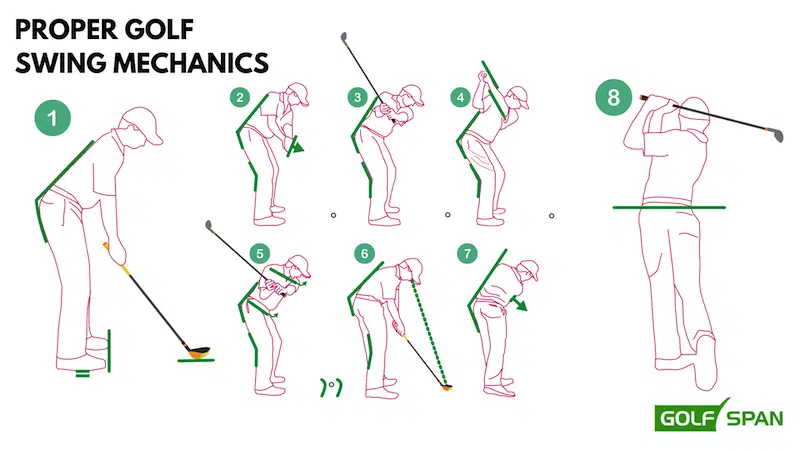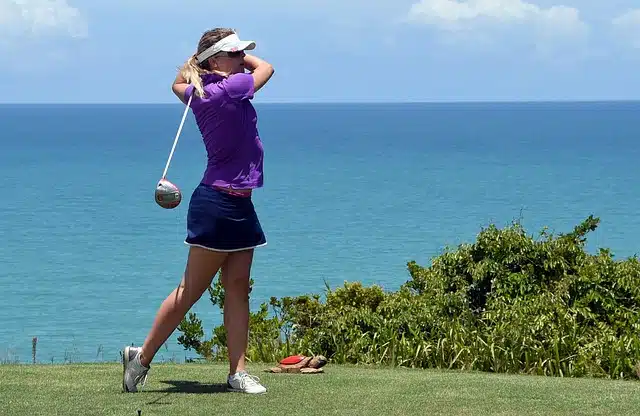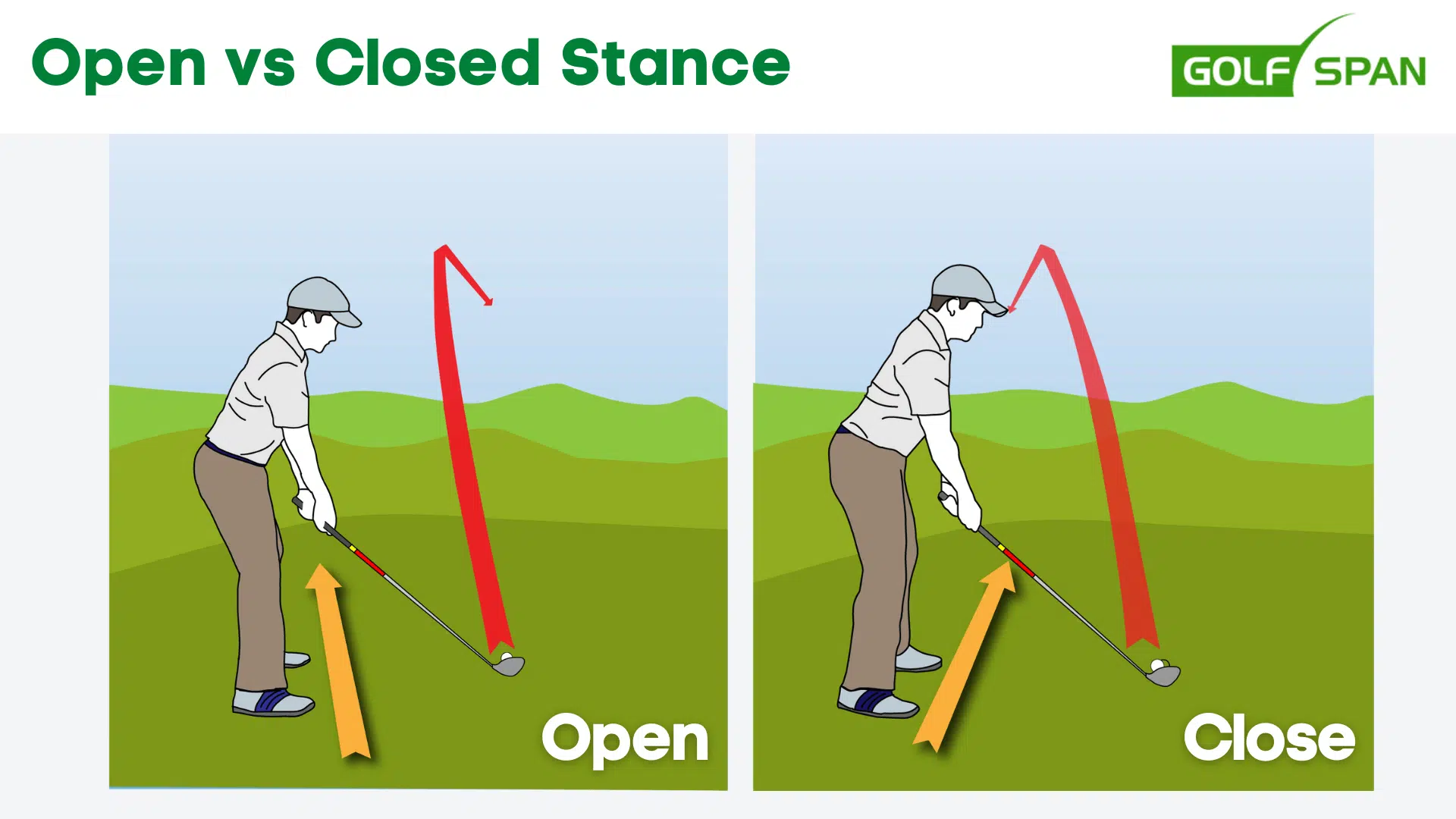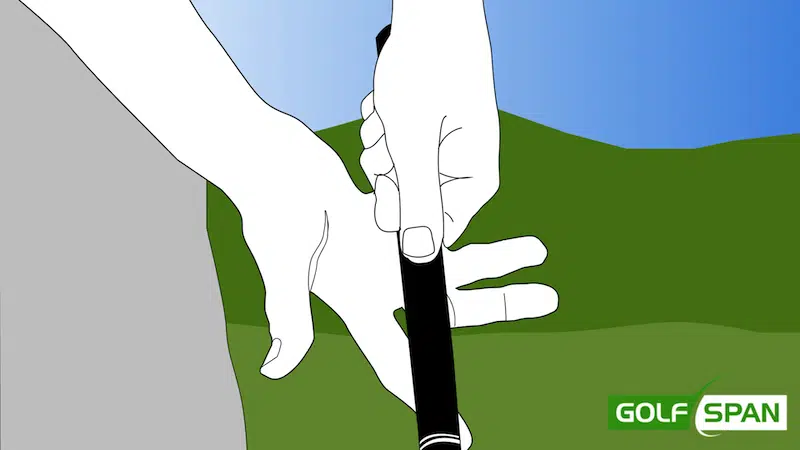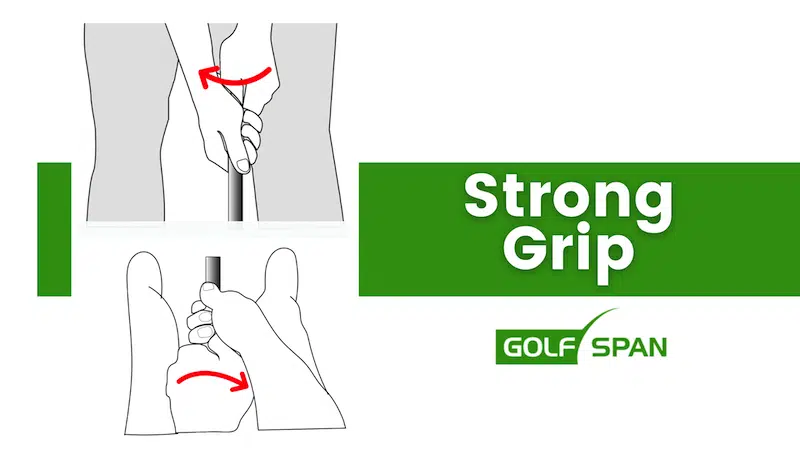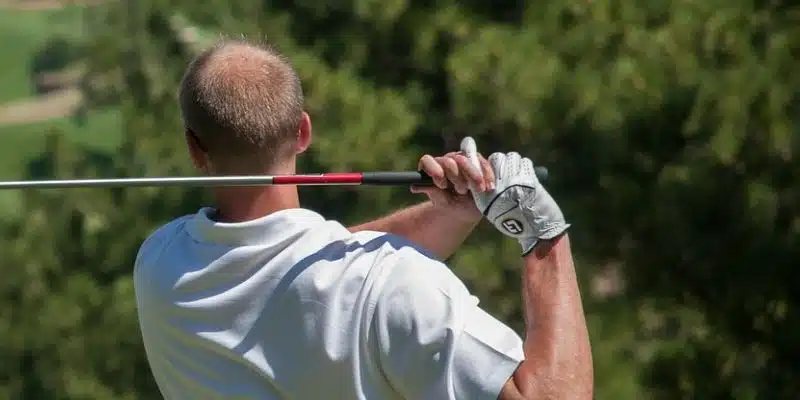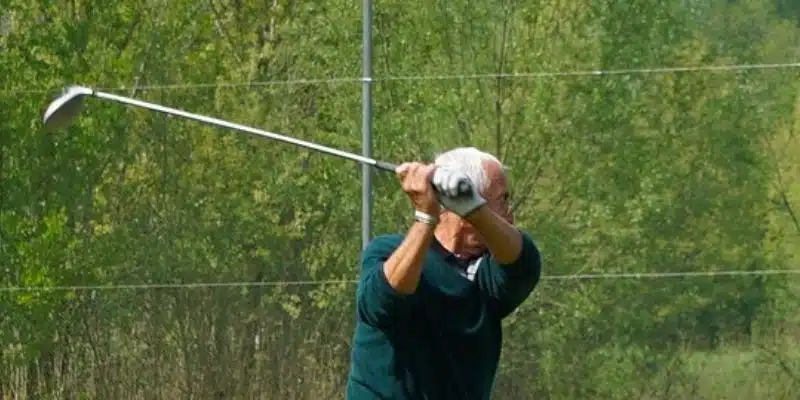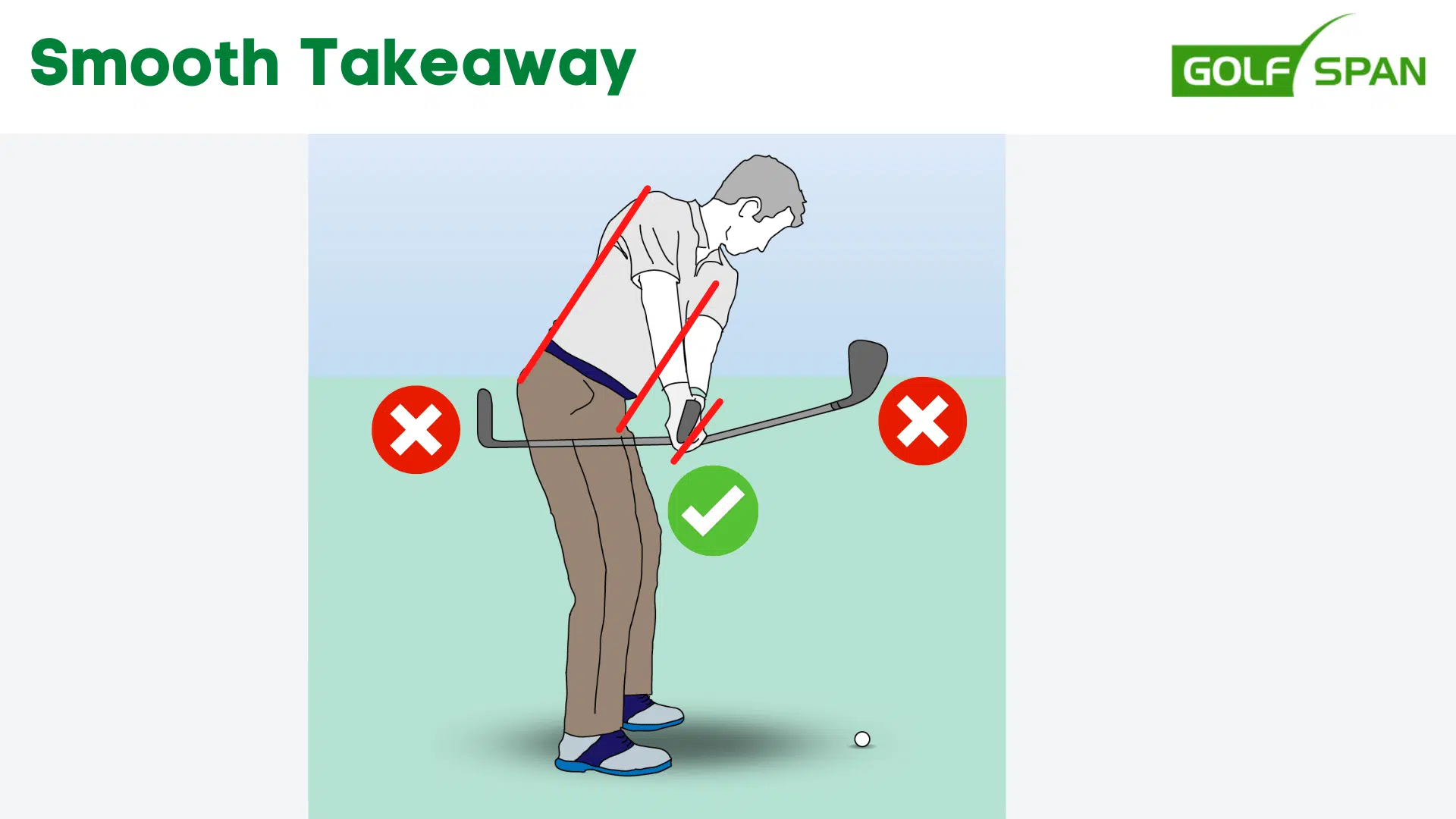Knowing how to swing a golf club seems simple. Yet, having a consistent swing with a fair amount of power can be one of the most difficult things in the world.
I’ve been golfing since I was a kid, and one thing I wish I had understood earlier was: proper swing mechanics.
Knowing each step to having a great golf swing can make it easier to find your mistakes, fix them, and stay on track during your round.
Here’s a quick step-by-step guide on how to swing a golf club:
- Address: Maintain a balanced and aligned posture at address
- Grip: Choose the right grip for your hand size and comfort
- Takeaway: Maintain the triangle between the club face and your shoulders
- Backswing: Push hands back in a straight line near your back leg
- Transition: Pause at the peak for a smooth and powerful downswing
- Downswing and Impact: Move hips and shoulders together for controlled impact
- Follow-through: Maintain momentum and form
You won’t want to miss the details of each step, though, since there’s a lot more to it than this. And if you make a mistake at any stage, it could ruin your swing for years.
But don’t worry. This golf swing breakdown will help your understanding; knowing how to swing a golf club is the first step.
Read on to learn the fundamentals of golf swing and how to swing a golf club to take your game to the next level.
Steps To Swing A Golf Club Properly
Knowing the mechanics of a comprehensive golf swing will aid in improving your golf shots.
To accomplish this, your golf swing should be effortless and uninterrupted, with a pause at the top of your golf backswing. Blending all the parts into one process when you swing a golf club is easier said than done.
These are the components of a comprehensive golf swing:
- Address
- Grip
- Takeaway
- Backswing
- Transition
- Downswing and Impact
- Follow-through
When you have conquered the mechanics, however challenging it appears at the outset, you will find the game of golf highly pleasurable.
These are the proper swing mechanics golf professionals use. Once you understand the specifics, it will be considerably simpler to pinpoint potential faults in your swing.
Before we assess the specific components of the golf swing, let’s discuss some aspects that will play a key role in the basic golf swing.
Golf Swing Concepts To Understand
Now, before I dive into each step and how you can start improving, let’s cover a few key concepts to understand.
Swing Planes
The swing plane is the trajectory that your golf club travels during the swing, and there are two main distinct planes that we will discuss here when you swing a golf club.
One-Plane
The most popular plane is the one-plane swing, where the club travels on the same plane during the backswing and the downswing.
Two-Plane
The second and more difficult is the two-plane swing. The backswing is more upright, and by dropping your hands during the transition, the downswing is on a flatter plane. The two-plane swing promotes an increase in swing speed and distance.
Your Power Comes from Your Body
Power in your swing is produced by moving your whole body in harmony and not merely your arms. Swinging with your arms will only result in unreliable and ineffective contact.
Coil Your Body
Coiling your body like a spring throughout the backswing creates tremendous power when released, resulting in optimum speed.
Keep Your Head Down
The natural predisposition of golfers is to look at where their ball is going instead of pausing to see contact between the clubface and the golf ball before looking up.
A fast and powerful swing will force your head up due to the impetus generated, but it is not the only cause for lifting your club head. This movement creates challenges in your swing and frequently leads to you topping or mishitting the ball.
This video explains some of the basic principles of how to swing in golf before we get into the finer details:
Read more: The Best Golf Swing Analyzers
How to Swing a Golf Club – Step-By-Step Golf Swing
1. Maintain Balanced and Aligned Posture and Stance at Address
Where you’re aligned is where your ball will go, so it’s kind important to incorporate these simple golf tips into your game. Your golf swing position and the swing itself aren’t all about the arms: correct posture provides the optimal power source for a harmonious and effective drive.
The Difference Between An Open And Closed Stance
An open stance swing is when the feet and hips are positioned away from the target line. The front foot is farther from the target line than the back foot, while the hips are open to the sky. This type of stance encourages an outside-in swing path, which can reduce distance and produce the dreaded slice.
A closed stance swing is when the feet and hips face the target line or cross paths with it. The back foot is further away from the target line than the front foot, and the hips are closed. This stance encourages an in-out swing path, which can help create draws or hooks.
Posture
Posture is one of the golf swing basics. Your golf posture is crucial in the setup when addressing the ball. Your swing relies on a rock-solid foundation retained during the process to deliver a solid strike.
Initiate the golf posture by aligning your body parallel to the target line for straight golf shots. Let your arms dangle down to your sides before gripping your club in a relaxed position. Your final swing technique golf position should be comfortable and prepared for action.
Body Alignment
To be accurate, you have to know where you want the ball to go before you can hit a good shot. Establish your target line. When addressing the ball, the direction your feet and shoulders are pointing is critical. These are the golf swing basics to playing a better game of golf.
Check your alignment. You want to align your feet and shoulders so that an imaginary line passing from your back shoulder to front shoulder — and back foot to front foot — is pointed directly at your target. This is called keeping your alignment “square.”
To check your alignment, get into your stance and place a golf club on the teeing area along with the tips of your toes. Step back from the golf club and look at the direction it’s pointing in. It should be pointed either at your target or at the hole itself.
Form a Direct Back
Ensure that your back is straight and not bent or arched. The swing should rotate around your straightened spine. Maintain your spine angle throughout the swing.
Flex The Knees
It is a natural athletic position to bend your knees slightly, and it will promote extra movement and power during the swing to enable you to keep your balance.
Too much flex in the knees results in too little flex in the hips, causing a body that is too vertical.
Push Out Your Rear End
Once you have straightened your back, push your rear end out slightly to offset the top half of your body that is bent over.
Balance
By distributing your weight equally on the balls of both your feet, you will make it simpler to shift your weight forward and backward during the swing process.
The weight distribution should be distributed equally between your two feet at address, and the weight will shift to your trailing foot in the course of the backswing and then to the leading foot in the downswing.
Ball Position
The ideal position is center for middle clubs, moving forward slightly forwards for longer clubs and backward (closer to the center) with the short clubs. The ball should be placed in the spot slightly before the point where the golf club makes contact with the ground.
Don’t stretch, and don’t have it too close.
Place your feet so that your front foot is slightly ahead of the ball position; this way, your club will be resting near the center of your body. Your feet should be wider than shoulder-width apart, with your golf ball toward the middle of your stance.
Typically, you want the ball to be in the middle of your body, but this will depend on your swinging golf club. With the ball positioned in the centerline of your stance, you want to ensure you have a good balance and are close enough to your golf club.
Play bigger clubs (such as hybrids or drivers) more towards your front foot and smaller clubs (like irons) towards the middle of your stance.
- If you’re a right-handed player, it will be the opposite. Your left foot will be about one foot — often less — closer to the hole than the ball is.
- If you’re a left-handed player, your right foot will be closer to the hole than the ball is.
Get close to the ball so that the middle of the clubface reaches the ball with your arms out straight but still relaxed. Don’t stand so close to the ball that you must bend your elbows to accommodate the club positioning. At the same time, don’t stand so far away that your arms are fully outstretched.
You want your upper body to be slightly bent toward the ball, and your torso bent away from the target, but not dramatically so. Tilt your upper body slightly away from your target.
2. Choose the Right Grip for Your Swing
The way you grip your golf club will affect the impact on your ball’s trajectory.
Grip Size
The grips that the club provides are normally a standard size. There are many sizes and thicknesses available to make it more comfortable. The standard grips are suitable for golfers with smaller hands. Golfers with larger hands require thicker grips.
The Golf Grip Is a Two-Part Process:
- The highest hand, or the lead hand, on your handle, is located on the golf handle.
- Then, a lower hand or trailing hand is added to the grip.
There are three different strengths of golf grip.
3 Types of Golf Grip Strength
-
Neutral Grip
The neutral grip starts by positioning your clubface square to the ball at address.
Position your leading hand on the grip and ensure that only the knuckles of the leading hand’s index finger and middle finger are visible. Position your trailing hand below your leading hand and ensure that only the knuckles of the index finger and the middle finger of the trailing hand are visible.
-
Strong Grip
The stronger grip promotes a closed clubface at impact, resulting in a draw or a hook due to your hands turning over.
Place your leading hand on the grip, followed by your trailing hand. Now the knuckle of the ring finger will be visible together with the two knuckles on the neutral grip.
-
Weak Grip
A weak grip is the opposite of a strong grip, with the hands leaning more toward the non-dominant side. This results in an open clubface at contact and a left-to-right ball trajectory.
3 Grip Types
The types of grips used by golfers are conditional on the golfers’ hand size and personal preference.
Vardon Grip
The Vardon Grip, also often described as the overlapping grip, was introduced by Harry Vardon around the turn of the 20th century. It’s the most used and recommended by experts. It is more suitable for golfers with larger hands and longer fingers.
The pinky finger of your trailing hand overlaps the trench between the index and middle finger of the leading hand. The thumb of the lead hand lies in the trailing hand’s lifeline.
Interlocking Grip
The second most used grip is the interlocking grip often employed by golfers with smaller hands and shorter fingers.
Like the Vardon grip, you connect the trailing hand’s pinky with the leading hand’s index finger. They interlock in the interlocking grip promoting control through the interlocking position. The thumb of the lead hand lies in the trailing hand’s lifeline.
Ten Finger Grip / Baseball Grip
The least popular grip is based on how batters grip a baseball bat with both hands placed beneath each other with no link between the hands. Golfers prefer this with difficulty flexing their fingers or with small hands.
Place your lead hand on the handle first and then the trailing hand. Push the hands together until the trailing hand’s pinky touches the index finger.
This video will give you more insight into the types of grips:
3. Takeaway: Maintain a Triangle Between Club Face and Shoulders
The start of your swing will influence its success, and any flaws at the beginning of the takeaway will follow through to the finish. You are not likely to recover from any shortcomings generated at the start.
Start by turning your torso to the right without sliding your lower body to the right, concentrating on coiling your shoulders to produce the power essential for the downswing. Make a long and effortless takeaway while keeping your hands and arms reasonably still. The swing should feel as effortless as possible.
Try the 1-Piece Takeaway
One of the more controversial golf techniques is the 1-piece takeaway, referring to the triangle between the club face and your shoulders. Even though the contemporary methodology for an early cock of the wrists happens before the hands reach waist-high.
The 1-piece takeaway results from maintaining the triangle in one piece for as long as possible by keeping your wrists intact. The early cocking of the wrists has led golfers to employ this technique but fail to achieve the maximum distance that they are capable of.
4. Backswing: Push Your Hands Straight Back Near Your Back Leg
The backswing is a crucial part of the golf swing where you raise the golf club towards the back from the address position to the top of the backswing. A poor backswing can and will majorly affect the full swing. Here are the steps to execute the backswing:
- Start by pushing the hands in a straight line back while holding them near to your back leg and keeping your front arm in a straight line while you do this.
- As the club face pivots towards the back between your leading arm and the club shaft, the shaft turns roughly parallel to the ground.
- During the backswing, you will rotate your torso and transfer the weight from the ball of your front foot to the ball of your back foot.
- When moving your arms parallel to the ground, your wrist will start to cock, and the club ought to be virtually at right angles to your front arm while the club is aiming marginally outside the golf ball.
- Continue pushing your hands and arms back until the club faces down the target line.
Top of the Backswing
Your front shoulder should turn behind the ball to reach the top of the backswing. Avoid the impulse to stand up and keep your posture and balance by bending your back leg. When reaching the top of the backswing, your body ought to be completely coiled and geared up for the downswing.
5. Transition: Pause at the Peak
After you have completed your backswing, there should be a slight delay before commencing the downswing. Hurrying your downswing is almost certain to prevent good contact.
The pause at the top end of the backswing allows you to harmonize all the moving parts in your swing, creating an effortless rhythm for solid contact. Hold your top position for a moment before you start your downswing.
6. Downswing and Impact: Move Hips and Shoulders Together
Following a smooth backswing and the transition at the top, the downswing should likewise be smooth to maintain command of all the parts engaged in the swing and avoid a violently fast downswing. The downswing must start slowly and build speed progressively until you reach maximum velocity at impact.
Initiate your downswing by sensing that your right shoulder and right hip drive in harmony in the ball’s direction and that your arms (not shoulders) are falling downwards for peak speed at impact.
The harmonious movement of the hip and shoulder—the hips will be ahead of the shoulder, allowing the lower body to lead the swing. By starting the swing in this way, your hips will turn to the left instead of sliding ahead too much, thus avoiding the reverse pivot and promoting the creation of maximum speed.
Starting the downswing by pushing your hips forward too soon encourages the body to lean towards the back, creating the reverse pivot that slows your swing down and inhibits you from achieving the highest speed you can.
Weight Transfer
You ought to transfer your weight from the ball of your trailing foot to the ball of your front foot just as you initiate your downswing. Maintain the flex in your front knee to aid the weight transfer to the front foot. Also, permit your bent knees to shift forward in the direction of the target.
Avoid transferring your weight too soon or beginning the movement of your hands too quickly as this will alter the angle of the clubhead and will adjust and influence the direction of the shot.
Impact
At the point of impact, your shaft should be tilting in the direction of the target, and your hands ahead of the ball. This position will promote contact with the ball before making it with the ground so you can hit the ball better.
7. Follow-Through: Maintain Momentum and Form
Follow-through is one of the golf swing fundamentals. Many golfers start thinking that once they create contact between the ball and the clubface the wing is complete. Although contact is important, stopping at that point will result in the deceleration of the head at the exact moment when acceleration should be at its highest.
This will create an incomplete action and severely affect your ball trajectory and balance.
In the finish position, your body ought to have twisted roughly 90 degrees, your belt buckle pointing towards the target, the club positioned behind you, your body stable, and your weight placed on your lead foot with the trailing foot balanced on its big toe.
Your posture should easily maintain this finish as if you are posing for photos as you watch the ball flying in the distance. That’s the proper way to swing a golf club.
6 Tips to Build a Great Golf Swing
Let’s look at some tips that you can use to build better golf and beat your buddies in the sport. You can use each of these golf swing tips to raise your game. I would recommend that you practice each of the golf tips individually until you master them.
Tip #1: Control Direction with Your Left Hand
You can control the club face and direction with the back of your left hand. During your golf swing, point the back of your left hand to the left of your target. Doing this action closes the club face and draws the ball. For shots where you want to fade the ball, point the back of your left hand to the right.
Many professional golfers will point the back of their left hand for as long as possible after impact to direct the ball to its target and improve accuracy.
Tip #2: Improve Golf Grip for Straighter Shots
How you grip the golf club will connect you to your swing, and you can refine your swing with an improved grip. Good grip on the club will make the shots fly straighter. Your hands should grip the club softly but firmly. Wiggle the club a bit to release the tension in your wrists. You need to practice the grip to discover what works best for you.
Tip #3: Build Your Own Golf Swing
Every golfer will have their own golf swing, and you shouldn’t focus too much on what it looks like. Golfers often give golf tips to others, but each person differs in what works for them. Your golf swing may look different from the textbook, but you must learn to see what works best for you. You can take lessons online as well.
Tip #4: Count for Better Tempo
Most beginner golfers swing too quickly, and this quick swing can throw off your accuracy. To remedy a fast swing, you can count throughout the process. You will count one when you start the swing, two when you reach the top of the backswing, three at the point of impact, and you end with four once you conclude with a balanced finish.
Tip #5: Know Your Target
Many beginner golfers think too much about the golf swing but neglect the targeted aim. The golf swing only matters when you hit the ball to where you want it to go. Pick a small target toward the center of the green and take a swing, but don’t let your brain focus too much on the golf swing. Obviously, your golf swing does matter, but you will get nowhere if you don’t focus on a target.
Tip #6: Refine Your Stance for a Better Strike
Many golfers need help to hit with the middle of the golf club head. This issue arises because of a poor setup; you can iron it out over time. You should aim for a golf stance that positions your body in a balanced and athletic place. Your body can rotate freely, and you can maintain this throughout the swing.
How To Shift Your Weight During Your Golf Swing
- Set up with a 50/50 weight split
- Consciously turn the shoulders and hips while transferring the weight to the heel of the right foot
- Turn doesn’t slide or sway away from the ball
- Stay centered around the spine
- The first downswing move is the weight transfer, followed by clearing the left hip
- Don’t start the downswing with the arms and shoulders
- Never rush the transition to the downswing
- Don’t change grip pressure during the swing
- Practice the Swing Sequence in slow motion
Weight at Address
Standing over the golf ball at address before hitting a tee shot, the weight should be split 50/50 and positioned on both feet’ balls. Some teachers advocate a 40/60 split with more weight on the back foot.
Either way, this balanced setup allows the player to move the weight onto the back foot during the backswing, load up the coiled power in the shoulders and hips, then transfer the weight onto the front foot, turn the hips, and uncoil the generated power with the arms, through the ball. A full follow-through sees the weight now at 90/10 on the front foot.
Turning, Not Swaying onto the Back Foot
It is important to understand the difference between swaying and turning. The hips and shoulders turn away from the ball, while the weight is transferred to the heel of the back foot. Sliding the hips backward is a very common fault and is a swing destroyer.
Do not let the weight shift to outside the back foot. By this, I mean don’t move the knee of the back leg outside the position it was at address. If this sounds complicated, let me simplify it.
Think of standing in a large barrel when you set up to the ball. Now any lower body movement must be contained within this barrel on both the backswing and the downswing. This was a Ben Hogan tip, and he was one of the best strikers of a golf ball ever!.
This will give a feeling of having to turn rather than sway or slide during the swing. A term often used in golf today is to remain “centered” over the ball. The spine is the center around which all movement is carried out.
Getting onto the Front Foot
We have discussed the weight transfer onto the back foot in detail, but the transition between shifting weight from the top of the backswing to the downswing is the toughest move in the golf swing. Here is where the swing sequence comes into play. The downswing is started with the weight shift to the front foot and the left hip turning or clearing away towards the target to make way for the arms to swing freely through the ball.
Over the Top Move
The most common swing fault with golfers is the “over-the-top” move. It refers to golfers starting the downswing with the arms and shoulders to overpower the ball. It is a score and swing wrecker of note! Duck hooks, slices, topped or thin shots mainly start here. The club shaft is pulled away from the body, and all the power is lost.
Rushing
For some unknown reason, we all tend to rush the change from the backswing to the downswing. It is as if someone is about to steal the ball unless it is hit quickly! By rushing, all the sequence is lost, and contact may be made with the ball, but the power loss is enormous.
Re-Gripping at the Start of the Downswing
Once the grip pressure is applied at address, it should not at any time be increased or decreased during the swing. It is another common fault that throws the club out of the intended plane, with disastrous results.
Weight Transition and Swing Sequence Practice
I cannot overemphasize the importance of getting the swing sequence and weight transition right if you want to improve your golf above “social” status. Stand in front of a mirror or large glass window and do all the sequence moves in slow motion to try to develop muscle memory. Do it without a club, but do it often.
Start with short half-shots with a wedge and go through the bag, hitting half-shots. Forget about where the ball goes. Just concentrate on transferring the weight correctly. Stop at the top of the backswing for a second, and then move the weight onto the front foot. Sometimes, this will help with rushing the shot.
What’s Also Involved In Improving Your Golf Swing?
Apart from the physical and technical aspects of swinging a golf club, your mind plays an equally significant role; therefore, keeping a strong mindset during your swing sequence is imperative.
Generating consistency in your swing involves preparation and perseverance. Building a fluid swing to maintain the same tempo and balance from the takeaway to the finish is sensible.
Steer away from using brute force to generate speed and start with an effortless swing and speed it up as you make headway without tensing up your swinging golf club.
Unlike many other sports where hand-eye coordination plays a substantial role, the golf ball is static when you strike it. That point makes performing the golf club swing more important than swinging at the right time, like in baseball.
FAQs
How Do I Stop Hitting the Ground behind the Ball?
Your golf club hits behind the ball for several reasons, including ball position, sliding the hips, head slide, loose leading arm, early release, and improper weight transfer. First, figure out the cause and then work toward improving it.
How Do I Keep My Head Down When Swinging?
Before you take a swing, position your head straight up and down. Especially during the downswing, keep from tilting your head to the right since this commonly creates the problem of putting your head down. Pay attention to how you position your head throughout the swing.
What Part of the Body First in Golf Swing?
For experienced golfers, the pelvis will normally move first. Watching professional golfers, you will notice how their lower body moves first as the upper body turns back.
Do You Keep Your Arms Straight When Swinging a Club?
You can take shots where you bend your arms, but most golf experts agree that straight arms give you better shots. Having straight arms will encourage rotation, power, consistency, and speed. All of those things matter when it comes to golf.
Final Thoughts
The golf swing is a complex process whereby many moving parts combine to connect the head and the golf ball.
You may struggle to execute this extraordinarily complex process without knowing the complete process of the golf swing. Knowing and understanding the golf swing mechanics will enable you to refine golf swing errors and improve your golf game so that you know how to swing a golf club properly.
While it does seem like a lot to think about, take it one step at a time and read through the article again from time to time to see where you might be lacking.
We hope this article explains the golf swing simply to support you in developing your swing. It can also aid you in the future to fix your swing when you encounter struggles when you hit the ball. Learning how to swing a golf club is an ongoing process that you improve over time.
Related Articles
Nick is the founder of GolfSpan and an avid golfer. He's not quite a pro but has over 15 years of experience playing and coaching golfers worldwide. His mission is to bring the golfing community a better experience when it comes to choosing the right golf gear and finding the right setup for your game.
